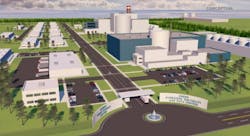Virginia Data Center Project Plans to Transition to Small Modular Reactors
A new data center project in Virginia plans to have nuclear power play a leading role in its energy strategy. The Surry Green Energy Center would be built near an existing nuclear power plant, with on-site small modular reactors (SMR) to follow. The plans for the huge data campus also feature hydrogen power generation.
Green Energy Partners (GEP), LLC, which was behind the Stonewall Energy Park in Loudoun County, Virginia, is under contract to purchase 641 acres adjacent to the existing 1.6 GW Surry Nuclear Power Station to create a new data center and renewable energy production center.
According to GEP vice-president of strategic development, Bill Puckett, the company plans to build at least 30 individual data centers on 3- to 5-acre plots, with construction set to begin in 18 months, presuming that all permitting can be completed by then. The plan is to run the data centers on existing power sources, then, using the revenue from the data centers, build to a hydrogen production facility and four to six 250MW small modular reactors to meet the long-term needs of the data centers and other facilities on campus.
Surry is in Southeastern Virginia, situated between the subsea cable landing station in Virginia Beach and a growing hyperscale data center cluster near Richmond, and just a few miles from a Mid-Atlantic Broadband fiber route..
If approval from state and federal agencies can be granted, GEP expects to build a system that would offer a renewable energy source for operations for no less than 10 to 15 years.
Nuclear and Hydrogen Power
Once the SMRs are deployed the facilities would be expanded to include a green energy hub, a location where hydrogen fuel is created. The Green Energy Center would use heat from the SMRs to bring pressurized water to 800 degrees, then using an electrolyzer to split the water into its component oxygen and hydrogen molecules, with the hydrogen being available for use as fuel that was created carbon-free (green hydrogen). This hydrogen fuel would potentially used on site or sold to customers to whom it would be blended with existing natural gas and shipped via pipelines already on site.
For the SMRs, GEP is working with the Idaho National Laboratory which has a commercial SMR project ongoing, currently scheduled to go online in 2029. Discussions are in process with SMR vendors, as well as the expected data center builders and potential customers. Quoted in Virginia Business, Puckett says that prospective customers and investors are already banging on their door. The same article also quotes Puckett as saying that depending on the SMR vendor selected, the power plants could start coming online in as little as five years. That's an aggressive timeline which would likely make these SMRs the first commercially deployed in the US, and potentially, worldwide.
This isn’t GEP’s first data center campus, nor even their first power plant, as it was the original developers of the Panda Stonewall Energy Station , a 778 MW natural gas fueled generation facility in Leesburg, Virginia. It has also built two other business parks in the Fairfax area.
Broad Ranging Future Benefits
The Surry location provides easy access to all the normal data center requirements as well as being in the prized Northern Virgina technology area. If GEP is able to get the necessary approvals for the SMRs and hydrogen production, the site has the potential to operate on completely carbon free, locally generated power. And if there is sufficient excess capacity for the campus needs, Green Energy Partners hopes to provide backup power to Northern Virginia data centers, addressing one of the ongoing concerns over the existing data centers in the area and one of the major stumbling blocks to continued growth.






